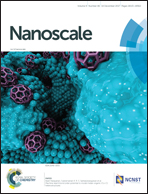Strain relaxation and ambipolar electrical transport in GaAs/InSb core–shell nanowires
Abstract
The growth, crystal structure, strain relaxation and room temperature transport characteristics of GaAs/InSb core–shell nanowires grown using molecular beam epitaxy are investigated. Due to the large lattice mismatch between GaAs and InSb of 14%, a transition from island-based to layer-like growth occurs during the formation of the shell. High resolution transmission electron microscopy in combination with geometric phase analyses as well as X-ray diffraction with synchrotron radiation are used to investigate the strain relaxation and prove the existence of different dislocations relaxing the strain on zinc blende and wurtzite core–shell nanowire segments. While on the wurtzite phase only Frank partial dislocations are found, the strain on the zinc blende phase is relaxed by dislocations with perfect, Shockley partial and Frank partial dislocations. Even for ultrathin shells of about 2 nm thickness, the strain caused by the high lattice mismatch between GaAs and InSb is relaxed almost completely. Transfer characteristics of the core–shell nanowires show an ambipolar conductance behavior whose strength strongly depends on the dimensions of the nanowires. The interpretation is given based on an electronic band profile which is calculated for completely relaxed core/shell structures. The peculiarities of the band alignment in this situation implies simultaneously occupied electron and hole channels in the InSb shell. The ambipolar behavior is then explained by the change of carrier concentration in both channels by the gate voltage.



 Please wait while we load your content...
Please wait while we load your content...